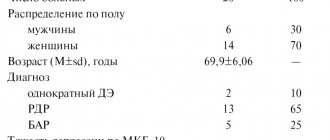Currently, for the treatment of depression, especially in outpatient practice, relatively new antidepressants are used - selective serotonin reuptake inhibitors (SSRIs), which have significantly fewer side effects than tricyclic antidepressants due to a selective effect on serotonin metabolism (selective inhibition of 5- NT).
SSRIs are represented by drugs such as: fluoxetine (Prozac), fluvoxamine (Fevarin), sertraline (Zoloft, Stimuloton, Asentra), paroxetine (Paxil, Rexetine), cipramil (Citalopram, Cipralex).
Unlike TCAs, a feature of the action of serotonergic antidepressants is their selective effect on the serotonergic system, initially identified in laboratory studies (Wong D., et al., 1974; Fuller R., et al., 1977). The effectiveness of SSRI therapy for depression is at least 65% (Mulrow D., et al., 2000)
Due to the affinity of these drugs and their active metabolites for serotonin receptors, serotonin reuptake is blocked at the level of presynaptic terminals, thereby increasing the concentration of the transmitter in the synaptic cleft, which in turn leads to a decrease in the synthesis and turnover of serotonin (Stark R., et al., 1985).
The selective, but nonspecific for a certain receptor subtype (Stahl S., 1993) action of SSRIs does not always increase the effectiveness of treatment, especially when it comes to the treatment of patients suffering from severe depression (Anderson I., Tomenson B., 1994; Burce M., Prescorn S., 1995).
SSRI drugs have completely different chemical structures and differ from each other in pharmacokinetic parameters, dosages and side effect profiles. The selectivity of 5-HT reuptake inhibition reduces side effects, improves tolerability and reduces drug discontinuation compared with TCAs (Anderson I., Tomenson T., 1994).
Table Comparative characteristics of SSRIs according to the intensity of the antidepressant effect
| A drug | Effect intensity |
| Paroxetine (Rexetine, Paxil) | + + + |
| Fluvoxamine (fevarin) | + + |
| Sertraline (stimuloton, zoloft) | + + |
| Cipramil (cipralex, citalopram, celexa) | + |
| Fluoxetine (Prozac, Fluxal) | + |
Note: +++—significant intensity, ++—moderate intensity, +—weak intensity of the effect.
It is necessary to emphasize the relative safety of SSRIs (fewer number and severity of side effects) and greater comfort of treatment (the possibility of carrying out therapy on an outpatient basis).
SSRIs are also characterized by low toxicity (the risk of death in case of poisoning or overdose is almost zero), as well as the possibility of using drugs in this group in patients with contraindications to the use of TCAs (heart rhythm disturbances, difficulty urinating due to prostatic hypertrophy, closed-angle glaucoma) ( Mashkovsky M.D., 1997).
It should be noted that the literature has reported cases of central and peripheral side effects during treatment with SSRIs (Baldessarini R., 1989).
These drugs are more expensive antidepressants than other drugs used to treat depression.
Most selective serotonin reuptake inhibitors (SSRIs) are long-acting and are used in fixed doses. The pharmacokinetics of various representatives of the SSRI group has its own characteristics depending on the age of the patients and somatic burden. Thus, the half-life of fluvoxamine increases slightly in elderly patients and patients with liver pathology (Raghoebar M., Roseboom H., 1988). The half-life of sertraline is also influenced by age (Warrington S.1988), and the effect of fluoxetine is quite significantly affected by the functional capabilities of the liver (Bergstrom M., Lemberg L, et al., 1988).
Clinical trials of SSRIs have demonstrated that they, like TCAs, are an effective treatment for most depressive conditions, including anxiety, sleep disturbances, psychomotor agitation and retardation. (Levine S. et al., 1987, Dunlop S. et al., 1990, Claghorn J., 1992, Kiev A., 1992).
Table Comparative assessment of the additional therapeutic effect of SSRIs
| A drug | Therapeutic effect |
| Fluoxetine (Prozac, Fluxal) | Disinhibiting |
| Fluvoxamine (fevarin) | Sedative, anxiolytic |
| Sertraline (stimuloton, zoloft) | Anxiolytic, antiphobic, vegetative-stabilizing |
| Cipramil (cipralex, citalopram) | Anxiolytic |
| Paroxetine (Paxil, Rexetine) | Anxiolytic, sedative |
Indications for the use of SSRIs are severe and moderately severe depression (such as simple) with mild anxiety and restlessness (Pujynski S., et al., 1994; Pujynski S., 1996). In addition, SSRIs can be used to treat personality disorders, including anger reactions and impulsivity.
The medical literature emphasizes the sensitivity of vital disturbances to the action of these antidepressants (Laakmann G. et al. 1988).
A number of studies have described that patients in whom melancholy predominated in the structure of the syndrome demonstrated a good therapeutic response when using SSRIs (Reimherr F. et al., 1990, Tignol G. et al., 1992; Mosolov S.N., Kalinin V. .V., 1994).
Considering the good tolerability of these drugs, they are recommended for use in old age.
At the same time, most researchers note a fairly high anxiolytic activity of SSRIs (Amin M. et al., 1989; Kiev A., 1992, Bovin R.Ya., et al. 1995, Ivanov M.V. et al. 1995). At the initial stages of the emergence of SSRIs in the domestic literature, there were indications of low effectiveness, and sometimes even increased anxiety when using SSRIs in patients with anxious depression (Kalinin V.V., Kostyukova E.G., 1994, Lopukhov I.G. et al. , 1994, Mosolov S.N., et al., 1994).
In recent years, studies have been conducted comparing SSRIs with TCAs. Most authors note that the activity of new compounds is comparable to traditional drugs (Guelri J. et al., 1983; Shaw D. et al., 1986; Hale A. et al., 1991, Fontaine R. et al., 1991 ). When comparing SSRIs with TCAs, traditionally used in the treatment of anxiety and depressive conditions, it is usually indicated that the differences in the effectiveness of the studied drugs in their ability to relieve anxiety are not statistically significant (Feighner J., 1985, Laws D. et al., 1990 , Avrutsky G.Ya., Mosolov S.N., 1991, Doogan D., Gailard V., 1992).
According to many authors, SSRIs are effective in some cases when the use of TCAs turned out to be ineffective (Weilburg JB et al., 1989, Beasley CM et al. 1990; Ivanov M.V. et al., 1991; Bovin R.Ya. et al. al., 1992; Serebryakova T.V., 1994; Bovin R.Ya., et al. 1995). According to Beasley C., Sayler M. (1990), patients resistant to TCAs are sensitive to new drugs in 50-60% of cases.
It is necessary to emphasize the greater safety of SSRIs compared to TCAs (fewer number and severity of side effects), greater comfort of treatment (the possibility of carrying out therapy on an outpatient basis) (Boyer W. Feighner J., 1996).
When taking TCAs, 30% of patients are forced to abandon treatment due to the severity of side effects, while when new drugs are prescribed, only 15% of patients have to interrupt their medication (Cooper G., 1988).
S. Montgomery, S. Kasper (1995) showed that the frequency of drug discontinuation due to side effects was 14% of patients treated with SSRIs and 19% with TCAs. The advantage of second-generation antidepressants is especially important during long-term therapy (Medavar T. et al., 1987).
R.Ya. Bovin (1989) points to an increased risk of suicide in the early stages of TCA therapy. While in most studies on SSRIs, the authors pay attention to the high anti-suicide nature of these drugs (Fava M. et al., 1991; Cohn D. et al., 1990; Sacchetti E. et al., 1991) .
In addition to the treatment of depression, attempts are increasingly being made to long-term use of antidepressants (fluoxetine, sertraline) to prevent its relapse.
Cohn GN et al., (1990), given the good tolerability of SA, recommend their use in gerontopsychiatry.
There is no consensus regarding the speed of onset of effect when using SSRIs. According to foreign authors, the clinical effect of SSRIs is detected later than TCAs (Roose S, et al. 1994). At the same time, domestic scientists indicate that SSRIs tend to have a faster onset of therapeutic effect compared to other antidepressants (Avrutsky G.Ya., Mosolov S.N., 1991).
In the SSRI group, various drugs differ in the strength of their action on receptors and the level of selectivity. Moreover, selectivity and potency do not coincide. Paroxetine was found to be a more potent inhibitor of serotonin relapse, while citalopram was more selective. Differences in the selectivity and power of action on receptors determine not only the characteristics of the therapeutic effect of a particular drug, but also the presence of side effects (Thopas D., et al., 1987; Hyttel G., 1993).
Other things being equal, relapses of depression are more likely to occur after treatment with fluoxetine than with paroxetine and after treatment with citalopram than with sertraline; with an almost equal number of relapses during treatment with sertraline and paroxetine.
Since fluvoxamine and paroxetine have a pronounced sedative and anti-anxiety effect, their spectrum of activity is similar to drugs such as amitriptyline or doxepin. Most other drugs, especially fluoxetine, more closely resemble the profile of imipramine, as they have a disinhibitory effect and can increase symptoms of anxiety and restlessness (Caley Ch., 1993; Pujynski S., et al., 1994; Montgomery S., Johnson F., 1995 ). In the domestic literature there are also indications of low effectiveness, and sometimes even increased anxiety when using SSRIs in patients with anxious depression (Kalinin V.V., Kostyukova E.G., 1994, Lopukhov I.G. et al., 1994, Mosolov S.N. et al., 1994).
Due to the disinhibiting effect, such drugs should not be used for anxiety, restlessness, motor disinhibition, insomnia, suicidal thoughts and tendencies. According to S. Pujynski (1996), psychotic forms of depression are a relative contraindication to the use of SSRIs. However, Feighner J., Bouer W (1988), on the contrary, note the positive effect of these drugs even in the psychotic version of depression.
The most common side effects when taking serotonin inhibitors are gastrointestinal disorders: nausea and vomiting, constipation and loose stools. A number of patients experience weight loss.
Table Comparative characteristics of SSRIs by severity of side effects
| A drug | Side effects |
| Paroxetine (Paxil, Rexetine) | + + + |
| Fluvoxamine (fevarin) | + + + |
| Sertraline (stimuloton, zoloft) | + + |
| Fluoxetine (Prozac, Fluxal) | + + |
| Cipramil (cipralex, citalopram) | + |
Note: +++ - significant severity of side effects, ++ - moderate severity of side effects, + - mild severity of side effects
The next most common side effects are: restlessness, anxiety, insomnia, and less commonly, increased drowsiness.
Patients are especially concerned about sexual disorders that may occur when using these drugs. The most common of them: decreased libido, weak erection and difficulty achieving orgasm. In case of severe sexual disorders that have developed during SSRI therapy, the dosage of drugs is usually reduced or discontinued for several days. In some cases, drugs that are serotonin antagonists (cyproheptadine) or drugs that enhance sexual function (yohimbine) are prescribed.
The most frequently mentioned contraindications to taking SSRIs include: hypersensitivity to the drug, pregnancy (cases of treatment of depression during this period with fluoxetine are known) and breastfeeding (the effect of SSRIs on the fetus and child development has been poorly studied), epilepsy, impaired renal and liver function. Drugs in this group cannot be used for poisoning with alcohol and psychotropic drugs. SSRIs should not be used earlier than 2 weeks after the end of therapy with non-selective MAO inhibitors, as well as together with other drugs with serotonergic action (Feihner J., Boyer W., 1996).
All registered SSRIs can provoke a phase change from depressive to manic in individuals with bipolar disease, but such a phase change occurs less frequently than with the use of TCAs (Kharkevich M.Yu., 1996). In addition, when treated with antidepressants for dysthymia, 10% of patients experience mild mania.
Due to the trend towards wider use of serotonin reuptake inhibitors in the treatment of depression, it makes sense to dwell on the characteristics of individual representatives of this group of drugs.
In his practical work, a psychiatrist in a number of cases encounters difficulties in distinguishing the clinical manifestations of depression from the side effects of SSRIs, SSRI withdrawal syndrome, as well as potentially life-threatening serotonin syndrome.
| Find out more: Professional help for depression |
In the practice of a psychiatrist, differential diagnosis of the withdrawal syndrome of these drugs, their side effects and serotonin syndrome with clinical symptoms of depression is of particular importance in the process of SSRI therapy. SSRI withdrawal syndrome, which occurs in the event of a rapid reduction in the dose of the drug or its abrupt withdrawal, is characterized by symptoms such as dizziness, nausea, anxiety and headache. As noted above, side effects of SSRIs usually appear in the first two weeks of therapy and include asthenia, diarrhea, nausea, anxiety, dizziness, sleep disturbance, nervousness and tremor. For serotonin syndrome, which occurs with an overdose of an SSRI or its combination with a TCA, abdominal cramps, psychomotor agitation, diarrhea, convulsions, tachycardia, hypo or hypertension, sweating, and hyperthermia are typical. In depression, the core of the depressive state is anhedonia.
Fluoxetine
One of the first serotonin reuptake inhibitors was fluoxetine (Prozac), which has been actively used since the early 80s to treat various depressive spectrum disorders. In addition, its positive effect in the treatment of bulimia was noted.
Fluoxetine is prescribed at a dose of 20 mg. once a day in the morning, if necessary, increase the dose to 40-80 mg. (in addition to tablet forms, a special solution of fluosetine 4 mg/ml is used abroad).
The drug is well absorbed when administered orally and is demethylated in the liver to form inactive metabolites and pharmacologically active norfluoxetine. Due to the peculiarities of metabolism, the effect of fluoxetine is quite significantly reflected in the functional capabilities of the liver (Bergstrom M., Lemberg L, et al., 1988). It suppresses the activity of hepatic cytochromes P4502D6, and therefore slows down the metabolism of a number of psychotropic drugs, including TCAs, with an increase in their concentration in plasma, which determines the possibility of toxic effects (Creve N., et.al., 1992).
The maximum concentration in the blood when taking fluoxetine is achieved after 6 hours. It has the longest half-life of all SSRIs, which in this case is two to three days, and the half-life of its active metabolite, norfluoxetine, reaches 7-9 days. This circumstance provides an advantage in the treatment of patients who may occasionally forget to take the next dose, but, on the other hand, it complicates the replacement of the drug with other antidepressants (especially MAOIs). It takes several weeks to achieve a stable concentration of the active substance. It was noted that, despite the anxiolytic effect, fluoxetine can increase the manifestations of anxiety and agitation at the initial stage of therapy.
In terms of its spectrum of action, fluoxetine is more reminiscent of the profile of imipramine, since it has a disinhibitory effect and can, as noted above, increase the manifestations of anxiety and restlessness (Caley Ch., 1993; Pujynski S., et al., 1994; Montgomery S., Johnson F., 1995). There is a point of view according to which, due to the disinhibitory effect, fluoxetine should not be used for anxiety, restlessness, motor disinhibition, insomnia, suicidal thoughts and tendencies, however, recent studies have shown that taking fluoxetine does not increase the risk of suicide (Freemante N., et.al ., 2000).
Fluoxetine (Prozac), compared to other SSRIs, eliminates signs of depression much more slowly (within 2-3 weeks), however, its final effect turned out to be similar to the effect of other drugs of this class (Edwards J., Anderson I., 1999). There are observations that fluoxetine is approximately equal to TCAs in its effectiveness in relieving symptoms of depression (Beasley C., et al., 1991).
At the same time, there is a point of view according to which fluoxetine is inferior to other SSRIs in its ability to relieve general manifestations of depression (Williams J., et al., 2000).
In the first days of using fluoxetine, and possibly also at further stages of treatment, nausea, akathisia, headaches, impaired visual acuity, and allergic skin reactions may be observed. Sexual dysfunctions have been reported when taking fluosetine (Guthrie S., 1991; De Vane C. 1994; Pujynski S., 1996).
Fluvoxamine
Fluvoxamine (fevarin), as a selective serotonin reuptake inhibitor, has a distinctly activating, mood-enhancing effect, it calms, stabilizes the activity of the autonomic system and can be recommended for a combination of depression and anxiety. In addition, the positive aspect of fluvoxamine treatment is its relatively rapid onset and smooth action, which, as a rule, contributes to the establishment of a good relationship between the patient and his attending physician.
Fluvoxamine is prescribed in a dose of 50 mg. per day once in the evening. The dose of the drug can be increased to 100 mg. (average dose of effectiveness) for 5-7 days. If necessary, the dosage of the drug can be further increased at intervals of 2-4 weeks (maximum daily dosage - 500 mg), starting with a dose of 150 mg. the drug is prescribed several times a day.
The active metabolites of fluvoxamine are unknown. The average half-life is 20 hours, plasma concentrations are not proportional to the dose taken
In most cases, symptoms of an anxiety disorder are eliminated earlier than those of a depressive disorder. This was clinically manifested by an improvement in the general condition of the patients, leading them to greater composure, confidence and external calm. The effectiveness of this drug is noted in patients with obsessive disorders and social phobia, in particular in childhood.
Adding fluvoxamine to atypical neuroleptics can reduce the severity of primary negative symptoms in patients with chronic schizophrenia. At the same time, comparative studies have shown that among the group of selective serotonin reuptake inhibitors, it has the greatest number of side effects (Freemante N., et al., 2000), sertraline has the least (Edwards J., Anderson I., 1999 ).
“I heard that antidepressants change personality. Will they turn me into a “zombie”?
This is perhaps one of the most common and most ridiculous myths regarding antidepressants. They won't actually change your personality. You will remain the same person, you will be able to work normally, communicate with people around you, you will live a full life - your mood will simply stabilize and become normal. A far-fetched “side effect” in the form of personality changes is not something to be afraid of. You won't become a zombie.
The most important thing is to correctly determine whether you have indications for taking antidepressants and choose the appropriate drugs and dosages. Only a specialist can competently solve these problems. Trust an experienced doctor at the Cordia Clinic, contact us:
Citalopram
Citalopram has a significantly higher level of selectivity for serotonin transporters compared to norepinephrine and dopamine transporters.
The drug is prescribed in a dose of 20 mg. per day once a day in the morning. For most patients, this dose is the most effective; the maximum daily dose of the drug is 60 mg.
Citalopram practically does not enter into drug interactions, due to the fact that it has little effect on the activity of some liver enzymes (cytochrome P450 enzyme system). Therefore, it is often used in the treatment of depressive conditions that develop as a result of chronic somatic diseases. Interdrug interactions of the drug are minimal. Under the influence of cytochrome P450, citalopram is converted into two main metabolites: demethylcitalopram and didemethylcitalopram. These metabolites have pharmacological activity, but much less than that of citalopram itself. The half-life of citalopram is 30 hours. It is characterized by a linear dependence of plasma concentrations depending on the dose in the therapeutic interval. For the treatment of severe depression, the dose of the drug should be increased.
The use of citalopram is recommended in general medical practice, in elderly patients and persons who have suffered a cerebral stroke.
When prescribing citalopram, the percentage of men with sexual dysfunction, a side effect that is relatively common when prescribing drugs in this group, turned out to be extremely small. Headache and nausea were the most common side effects of citalopram treatment during the first two weeks of treatment.
How do you know which antidepressant is best to start with?
Initially, the doctor prescribes the drug that, in his opinion, is best suited for a particular patient. It is impossible to know for sure what will work more effectively, but there are some factors that you can focus on: the type and symptoms of depression, side effects of medications, the general health of the patient, and concomitant diseases.
If you have family members with depression and certain medications work well for them, chances are the same medications will work for you.
Antidepressants can be prescribed during pregnancy and breastfeeding, but with caution. The doctor must carefully weigh the possible risks.
Sertraline
Sertraline (Zoloft, Stimuloton, Asentra) is characterized by a thymoanaleptic (anxiolytic) effect of moderate severity. There are no vegetative stabilizing, sedative, timerectic, adrenergic and anticholinergic (muscarinic) effects. The drug does not affect psychomotor functions, has a weak antiphobic and very weak hypotensive effect.
Indications for use are mild to moderately severe melancholy depression with secondary anxiety and somatoform disorders. After obtaining a satisfactory effect, continuing treatment with sertraline helps prevent relapse of depression or its subsequent occurrence.
Sertraline is also used to treat obsessive-compulsive disorder (OCD).
As a rule, the antidepressant effect occurs after one week of therapy.
After achieving the initial effect, long-term treatment with sertraline for up to 2 years ensures its sufficient effectiveness and good tolerability. Sertraline is used to treat panic disorders and post-traumatic stress disorder syndrome (PTSD). The initial therapeutic effect in this case may appear within 7 days, but the full effect is usually achieved later - after 2-4 weeks (possibly over a longer period of time, especially with OCD). There is a point of view according to which the drug usually reduces secondary anxiety associated with melancholy depression.
Sertraline (Zoloft, Stimuloton) is a relatively low-toxic antidepressant from the SSRI group; it is used in child psychiatry, as well as in cases of depressive spectrum disorders that develop after an acute episode of schizophrenia.
Sertraline is prescribed in a dose of 50 mg. per day (usually once a day in the morning, regardless of meals). The dose can be increased by 50 mg. in Week. Recommended daily doses: for inpatient treatment of depression - 50-100 mg, for outpatient use - 25-50 mg. If necessary, the dose is increased at intervals of 2-4 weeks (maximum daily dose - 200 mg).
At therapeutic doses, sertraline inhibits the uptake of serotonin by platelets. It is extensively metabolized in the liver, approximately 98% of it is present in the body in protein-bound form, and its main metabolite has weak pharmacological activity. Unlike most antidepressants, it binds preferentially to a1-glycoprotein, whereas other drugs interact primarily with albumin.
The half-life of sertraline is influenced by age. In children, sertraline metabolism is more active (Warrington S.1988). Considering the latter circumstance, it is recommended to use the drug in children in a lower dose to avoid excessive levels of its concentration in plasma. At the same time, according to other authors, the pharmacokinetic profile in adolescents and elderly people does not differ significantly from the profile of patients aged 18 to 65 years.
Sertraline is slowly absorbed over 4-6 hours, eliminated through the gastrointestinal tract and kidneys, the equilibrium concentration of the drug is achieved within one week after the start of treatment.
The average half-life of sertraline is 22-36 hours. Steady-state concentrations of sertraline are established after 1 week of treatment.
Kidney pathology has almost no effect on the clearance of sertraline. At the same time, with liver pathology, the half-life of sertraline in serum, as well as its concentration in plasma, increases by almost 50%.
Side effects: tremor, nausea, dry mouth, diarrhea. Typically, side effects resolve spontaneously by the end of 4 weeks of therapy. Early unwanted side effects are especially common in the treatment of panic disorders.
Contraindications to the use of the drug are liver and kidney diseases with impaired function. After discontinuation of the drug, MAOIs are prescribed no earlier than 5 weeks later.
With chronic use of sertraline, addiction develops to it, since its prolonged use leads to a decrease in the number of its receptors (Anthony P., et al., 2002).








